NEWS
"Under the Sea 3D" Production Notes
27 Jan 2009 By TNPihl (JCO Editor-In-Chief)
 Excerpt from Howard Hall’s Production Journal: January 11, 2008:
Excerpt from Howard Hall’s Production Journal: January 11, 2008:As I write this, we are at 30,000 feet, en route to Port Moresby, Papua New Guinea. Today is one year and three days since Michele and I began preproduction on this, our most ambitious IMAX 3D production ever. The logistics have been daunting. I can’t wait to get my hands on the ridiculously huge camera and slate it with brace #1. Soon I’ll be making that first dive and, for me, that’s what it’s all about.
Filmed with the incomparable scope and clarity of IMAX technology, "Under the Sea 3D" offers an intimate look into an underwater world few people have ever seen, and the exquisitely beautiful, sometimes treacherous and often comical creatures that live there.
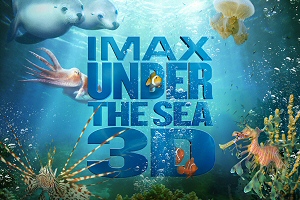
“Most people don’t even know these animals exist,” says director Howard Hall, a renowned documentary filmmaker and diver with extensive experience capturing marine wildlife on film. Hall, the first person to take an IMAX 3D camera underwater, in the 1994 feature “Into the Deep,” also serves as director of photography on “Under the Sea 3D.”
“In addition to Great White Sharks, you’ll see creatures like the Dwarf Minke Whale, the Chambered Nautilus and Big Fin Reef Squid. Our main goal in making these films is to bring animals that are little known, or not known at all, to the screen, to let people see how strange and wonderful they are. Plus,” Hall adds with a smile, “it gives me an excuse to go play in the ocean”— a passion he has been pursuing, and sharing, for more than 30 years.
With an aim toward protecting the ocean wildlife for future generations, Hall also believes, “People need a reason to care about coral reefs. My hope is that once they see these animals and realize that they’re not only remarkably beautiful but that they have their own interesting behaviors and personalities, they will fall in love with them and think it would be nice to have them around in coming years.
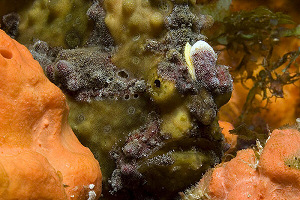
© Warner Bros. Pictures. A Warty Frogfish (Antennarius maculatus)
waits patiently for its next meal to swim by, as it sits
camouflaged in the temperate waters of New Britain, Papua New Guinea.
“There are many issues concerning the marine environment, certainly too many to cover within the context of one film,” he acknowledges. “On our previous film, we touched upon the importance of biodiversity; this time, we address the potential effect of climate change on ocean life.”
Taking it Further This Time
Having explored areas off the coast of California and the Baja Peninsula, North Carolina, British Columbia, the Gulf of Mexico, Hawaii and the Bahamas for “Deep Sea 3D,” Hall and his team wanted the new film to extend into more remote locales.
 Production Journal: October 15, 2008, Gunung Api Island:
Production Journal: October 15, 2008, Gunung Api Island:For those interested in looking at our location today on Google Earth, you probably won’t even see the island. This is a small rock less than a mile in diameter. It sticks up like one end of a football and that shape extends down into very deep water. There are only a couple of narrow ridges where we can put our feet down to work. Mostly the bottom is rubble or volcanic rock. Below one hundred feet, though, the invertebrate life becomes prolific and spectacular.
Says Hall, “For "Under the Sea 3D," we wanted to introduce audiences to some of the most exotic marine life, and that meant more distant and less accessible regions.”
“There are always more stories to tell,” adds Michele Hall, an avid diver herself as well as a wildlife photographer and producer for Howard Hall Productions, whose creative collaborations with her husband include “Deep Sea 3D” and the IMAX feature documentaries “Into the Deep” and “Island of the Sharks.” “We raised the bar geographically this time by traveling to New Guinea, Australia and Indonesia to show people the variety of marine wildlife in those waters.”
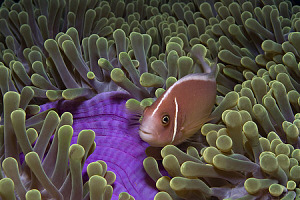
© Warner Bros. Pictures. A Crocodilefish hides among rocks
off the coast of Papua New Guinea.
Just north of Australia and the Coral Sea lies a vast region known as the Coral Triangle. Spanning several hundred miles, it encompasses the waters of Indonesia, Malaysia, The Philippines, Timor-Leste and Papua New Guinea, and extends as far as the Solomon Islands. It is home to approximately 40 percent of the world’s reef wildlife population, including more than 75 percent of documented coral species and some 3,000 individual species of fish, as well as sea turtles, mollusks, crustaceans and marine mammals such as dolphins and whales.
Says Michele, “The Coral Triangle is truly the center of biodiversity and a very significant area rich with ocean life. We were especially eager to explore and document it for the film.”
Once again, the filmmakers turned to IMAX as the most exciting and authentic way to bring their latest odyssey to life for moviegoers.
Howard attests, “Shooting with IMAX cameras can be enormously challenging because of the size and bulk of the gear and its complexity. But when you see those images projected in an IMAX theatre it’s a stunning experience, and there isn’t a director on earth who wouldn’t appreciate that. Once you have that opportunity, it’s hard to go back to a regular frame. The image quality is so precise, it’s virtually identical to what we experienced when we were down in the water—the same colors, the same texture, the same proximity. Even in 2D projection, the length and breadth of the frame is still IMAX. It makes you feel as if you could reach out and touch these animals…although in most cases, you wouldn’t want to!”
Adds Michele, “Often, I see things on the film that I didn’t see when I was diving. There’s one shot of a Giant Cuttlefish going after a crab, and it wasn’t until I watched the dailies that I noticed the detail of its eyes and skin.”
The Halls agree it’s this level of quality that makes the effort worthwhile. Altogether, production on "Under the Sea 3D" involved Howard and his crew each spending more than 350 hours underwater and 110 days at sea to capture almost ten hours of raw footage—not to mention the daunting task of transporting, loading, assemb ling and breaking down more than 8,000 pounds of equipment, including the 1,300-pound camera in its waterproof housing.
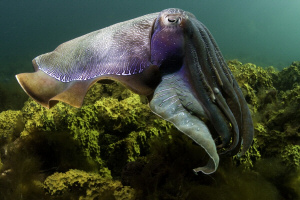
© Warner Bros. Pictures. A Giant Cuttlefish has the ability to show
the whole spectrum of color on his leathery skin. Which is good
for blending in and surviving.
Michele, who managed a great portion of the day-to-day logistics, including chartering boats for the dive team, laughingly recalls lo cal reaction to the state-of-the-art IMAX equipment. “I told people how big the camera was. I showed them pictures. I asked in advance for modifications to be made to their boats. But when we showed up with our 8,000 pounds of gear and the massive came ra, they’d just shake their heads and say, ‘We had no idea.’ We tried to warn them, but they just didn’t believe it.”
Typically, there were four people underwater at any given time—Howard and cameraman Peter Kragh, plus two divers to assist with spotting and maneuvers. Three additional divers were dedicated to the launch-and-recovery protocol, lowering the camera into position or hoisting it topside for fresh film or new lenses, while Howard and the first team remained below to prepare their next shot. This way, those at the lower depths avoided multiple rounds of decompression and could, instead, remain in place for upwards of six hours at a stretch using closed circuit mixed-gas re-breathing apparatus that allows dives of much longer duration than traditional SCUBA tanks.
Meanwhile, on the boat, Michele and two camera assistants supervised the reloading of film and speedy return of the precious cargo to Howard’s waiting arms, aware that every minute’s delay could potentially cost them the best shots of the day.
In addition to the camera, Howard describes, “The tripod itself is 75 pounds. Then, to keep everything stable in the current, we usually put another 100 pounds of lead on top of that. Of course, these weights are relative underwater. When the camera is off the tripod, it doesn’t actually weigh anything. It’s neutrally buoyant. But it still has enormous mass, meaning that once it starts moving it doesn’t want to stop. And you certainly don’t want to be caught between the camera and a rock.”
Film rolls through the IMAX camera in double strips, simultaneously capturing left- and right-eye perspective on 15/70mm, making it the highest resolution camera in existence with the most sophisticated dual-strip technology. Its stereo 3D lenses are spaced to duplicate the distance between human eyes, with each lens recording the image received though each eye on the two corresponding film strips. Owing in part to this complexity, each dual roll of IMAX film records only 3 minutes. Consequently, the team did extensive preparation and location scouting before a single frame was exposed.
Howard outlines, “Our production schedule was quite long. The first year was spent doing homework, as well as visiting each location to make the dives, find the animals we wanted to spotlight and get a feel for the practicality of bringing the camera there.”
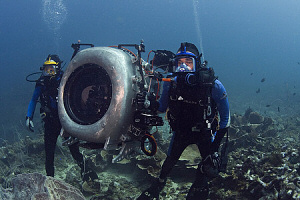
© Warner Bros. Pictures. Launch and Recovery Divers Dave Forsyth
and Richard Herrmann help to position the massive IMAX® 3D camera
in preparation for Director Howard Hall to capture his next shoot
in the South Coast of New Britain, Papua New Guinea.
Even so, their script was changing all the time. “We start with a very detailed plan and try to stick to it as much as possible but, frankly, sometimes the animals have other ideas,” he continues. “Often, they have better ideas. So the script gets changed on a continual basis as we progress through physical production, until I turn everything over to Toni Myers. We’re fortunate in that Toni is not only our producer but also our editor.”
Myers began her association with large-format filmmaking on the multi-screen documentary “Polar Life” and, most recently, directed the IMAX production “Space Station 3D.” She served with the Halls as producer and editor on “Deep Sea 3D” and was happy to rejoin them on their new excursion, proclaiming, “Howard is an absolute genius at capturing animal behavior and getting the most unique sequences I’ve ever seen. I don’t know how he does it because this is all in the wild. We have very specific action in mind, but there are always happy accidents.”
"Under the Sea 3D" marks executive producer Graeme Ferguson’s third collaboration with the Halls. A co-founder of IMAX Corporation, he first approached the documentarian when the company sought to produce its first oceanic feature. “I asked, ‘Who is the best underwater filmmaker in the world?’” Ferguson recalls. “It was Howard Hall. My job was then to persuade him to work in IMAX 3D and, fortunately, he accepted the challenge.”
For Ferguson, “The most interesting aspect of non- fiction is the same as it is with fiction: telling a story and having characters that hold your interest. Here, those characters are not people—they’re fish and octopi and other sea creatures—but they each ha ve their destiny and their purpose in life, too. And that’s the story we’re telling.”
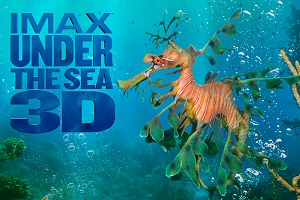
Finally, "Under the Sea 3D" needed a narrator who could give these stories the life and depth they deserve, as well as the humanity—a task entrusted to the multi-talented Jim Carrey. Says Howard, “Jim brings not only his dramatic capabilities to our narration but he has that essential humorous edge too, to bring out the parts of it that are very funny. There are a lot of fun and light moments in the film.”
-- Click to comment this article.
« Newer article | Overview | Older article »









